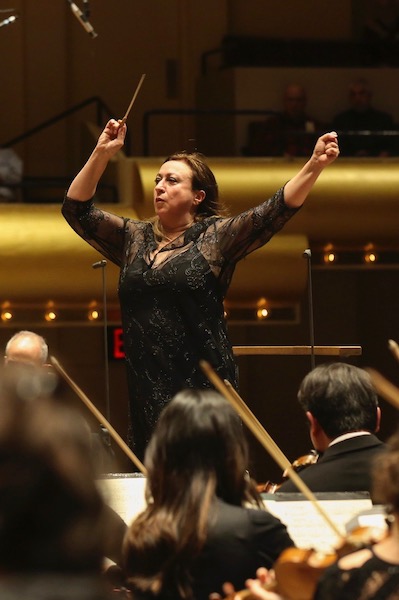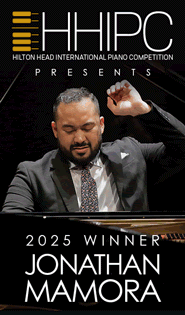Young leads Philharmonic in a wrenching, inevitable Mahler Sixth

Simone Young conducted the New York Philharmonic in Mahler’s Symphony No., 6 Thursday night at David Geffen Hall. Photo: Caitlin Ochs
When Gustav Mahler finished his Sixth Symphony, the final movement had three hammer blows of what he thought of as fate, each cutting the music down as it neared a triumphant moment. Mahler was not only superstitious enough to believe in fate, but enough to remove the final blow—literally the crack of a huge hammer—from the score. He didn’t want to take his chances.
As chance would have it, Thursday night the New York Philharmonic played Mahler’s Symphony No. 6, and did it with all three hammer blows. They came unto the direction of conductor Simone Young, who was substituting for Jaap van Zweden. The Philharmonic’s music director was scheduled to lead this week’s subscription program, but suffered a second-degree burn to his shoulder and is out of action for at least this week.
Young, recently the music director of the Hamburg Philharmonic and familiar at many major opera houses, was available and is an important interpreter of the late romantic operatic and symphonic repertoire. She is a commanding presence, bristling with energy and purpose, and the orchestra delivered a tremendous performance, one that even superseded the memory of this same work under Semyon Bychkov three years ago.
The three hammer blows are Young’s preference, as can be heard on her recording of the symphony. That was the most obvious of her interventions, which were otherwise subtle, judicious, and which came off brilliantly.
The Philharmonic played the Sixth with the Scherzo second and the Andante third, the most common and tradition-bound option for a question Mahler left open. There’s not necessarily anything notable about that, except for how Young made it work.
She played up the instrumental colors to the utmost—this was neon, lit and exciting.The prominence she gave to certain instruments, especially the xylophone and the two celestas, in the first movement carried over into the scherzo. That cemented a relationship between the two, the latter becoming an extreme development of the former.
And so also the Andante became a beautiful and wrenching prelude to the tragic final movement. Mahler already has an uncanny sense of growth in his music, with lines germinating from basic ideas, branching out in surprising, yet understandable, ways. This structure, and the way it was executed under Young, had a natural, organic quality.
This Sixth grew Thursday night, and changed. Though this took 80 minutes or so, there was no sensation of passing time, only movement. The pace was always right—opening on the brisk side, Young took a ritardando when the opening section of the first movement grew quiet, and this prepared the “Alma” theme. Often sounding brittle in contrast to the threatening start, with roots in the measures and mood that preceded it, Thursday night the music was substantial and comforting to maximum effect.
The Philharmonic could not possibly have sounded or played better. As with Young’s conducting, there was the feeling of explosive energy that was still under complete control. Extremes of expression were thrilling, gorgeous, and moving in turn, from the massive chord at the end of the first movement to the delicacy of the trio in the Scherzo, from the deep and forceful (but never bathetic) feeling in the Andante to the steely, driving line running through the marches and fanfares of the finale.
Even in this sprawling, phantasmagorical work, everything was tight and important, nothing was superfluous or for effect.
That included the hammer blows, the third one coming with great anticipation and satisfaction. That included the cowbells—they were set above and outside the orchestra, in the first box stage-right. Underplayed at just the right level, they were completely integrated into the orchestral textures and the ones used—with fine definitions of pitch and complex and intriguing metallic timbres—had the quality of a full instrument.
The performance culminated in the final pizzicato. Just as Primo Levi ends The Periodic Table by describing how the period that finishes the book came to be, so Young shaped the enormous mass of music toward this moment. Like a destination that gradually grows larger in vision as one approaches it, the final note lay in sight from the moment the opening march began, and seeing it ahead all along, all through the dazzling colors and complex feelings, it came as dark and profound as Mahler meant it to be.
This program repeats 11:00 a.m. Friday and 8 p.m. Saturday nyphil.org







Posted Apr 13, 2019 at 2:26 pm by DorothyT
I was fortunate to attend Thursday’s concert to see a brilliant conductor and an orchestra that has been yearning for such a one.
The difference between Jaap van Zweden and Simone Young is that the former keeps time and the latter makes music.
Posted Apr 13, 2019 at 2:42 pm by Rick Schindler
We saw the Friday performance and this review is an excellent description of it. This is recognizable as the program we saw; the supercilious New York Times review is not.
Posted Apr 16, 2019 at 12:53 pm by doctorjohn
I LOVE the comments, so closely mirroring my own sentiments.
I went to the Friday performance and sat close to the stage on the Third Tier.
There can be no greater tribute to the conductor and performance than the fact that the viola principle, Cynthia Phelps, was wiping away her tears just before her last notes to end the piece.
Posted Apr 17, 2019 at 11:27 pm by Jon Rachmani
Thank you for an excellent review. I heard her brilliant conducting on Saturday night and was utterly shattered by its tragic force. Her attention to lyricism was likewise precise and passionate. Without a doubt, the finest production of the 6th I’ve heard. Brava, Maestra Young!